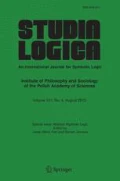Abstract
In this paper we study the semantic data complexity of several controlled fragments of English designed for natural language front-ends to OWL (Web Ontology Language) and description logic ontology-based systems. Controlled languages are fragments of natural languages, obtained by restricting natural language syntax, vocabulary and semantics with the goal of eliminating ambiguity. Semantic complexity arises from the formal logic modelling of meaning in natural language and fragments thereof. It can be characterized as the computational complexity of the reasoning problems associated to their semantic representations. Data complexity (the complexity of answering a question over an ontology, stated in terms of the data items stored therein), in particular, provides a measure of the scalability of controlled languages to ontologies, since tractable data complexity implies scalability of data access. We present maximal tractable controlled languages and minimal intractable controlled languages.
Similar content being viewed by others
References
Abiteboul, Serge, Richard Hull, and Victor Vianu, Foundations of Databases, Addison-Welsey, 1995.
Artale Alessandro, Diego Calvanese, Roman Kontchakov, Michael Zakharyashev: The DL-Lite family and relations. Journal of Artificial Intelligence Research 36, 1–69 (2009)
Baader, Franz, Diego Calvanese, Deborah McGuinness, Daniele Nardi, and Peter F. Patel-Schneider, The Description Logic Handbook: Theory, Implementation, and Applications, Cambridge University Press, 2007.
Barwise Jon, Robin Cooper: Generalized quantifiers and natural language. Linguistics and Philosophy 4(2), 159–219 (1980)
Bernardi, Raffaella, Diego Calvanese, and Camilo Thorne, Lite natural language, in Proc. of the 7th Int. Workshop on Computational Semantics (IWCS-7), 2007.
Calvanese, Diego, Giuseppe De Giacomo, Domenico Lembo, Maurizio Lenzerini, and Riccardo Rosati, Data complexity of query answering in description logics, in Proc. of the 10th Int. Conf. on the Principles of Knowledge Representation and Reasoning (KR 2006), 2006, pp. 260–270.
Eiter Thomas, Georg Gottlob, Evgeny Dantsin, Andrei Voronkov: Complexity and expressive power of logic programming. ACM Computing Surveys 33(3), 374–425 (2001)
Fuchs, Norbert E., and Kaarel Kaljurand, Mapping Attempto Controlled English to OWL-DL, in Demos and Posters of the 3rd European Semantic Web Conf. (ESWC 2006), 2006.
Horrocks Ian, Peter F. Patel-Schneider, van Frank Harmelen: From \({\mathcal{SHIQ}}\) and RDF to OWL: The making of a web ontology language. Journal on Web Semantics 1(1), 7–26 (2003)
Jurafsky, Daniel, and James Martin, Speech and Language Processing, 2nd edn., Prentice Hall, 2009.
Kaljurand, Kaarel, and Norbert E. Fuchs, Bidirectional mapping between OWL DL and Attempto Controlled English, in Proc. of the 4th Int. Workshop on Principles and Practice of Semantic Web Reasoning (PPSWR 2006), 2006, pp. 179– 189.
Krisnadhi, Adila, and Carsten Lutz, Data complexity in the \({\varepsilon \mathcal{L}}\) family of description logics, in Proc. of the 14th Int. Conf. on Logic for Programming, Artificial Intelligence, and Reasoning (LPAR 2007), 2007, pp. 333–347.
Montague Richard: Universal grammar. Theoria 36(3), 373–398 (1970)
Ortiz Magdalena, Diego Calvanese, Thomas Eiter: Data complexity of query answering in expressive description logics. Journal of Automated Reasoning 41(1), 61–98 (2008)
Pratt Ian, Allan Third: More fragments of language. Notre Dame Journal of Formal Logic 47(2), 151–177 (2006)
Schwitter, Rolf, Kaarel Kaljurand, Anne Cregan, Catherine Dolbear, and Glen Hart, A comparison of three controlled natural languages for OWL 1.1, in Proc. of the 4th Int. Workshop on OWL: Experiences and Directions (OWLED 2008), 2008.
Staab, Steffen, and Rudi Studer (eds.), Handbook on Ontologies, Int. Handbooks on Information Systems, Springer, 2004.
Thorne, Camilo, Query Answering over Ontologies Using Controlled Natural Language, KRDB Dissertation Series, Faculty of Computer Science, Free University of Bozen-Bolzano, 2010.
Thorne, Camilo, and Diego Calvanese, Exploring Controlled English ontologybased data access, in Proc. of the 2009 Workshop on Controlled Natural Language (CNL 2009), vol. 448 of CEUR Electronic Workshop Proceedings, http://ceur-ws.org/, 2009.
Vardi Moshe Y., The complexity of relational query languages. in Proc, of the 14th Annual ACM Symposium on Theory of Computing. 1982, pp. 137–146
Author information
Authors and Affiliations
Corresponding author
Rights and permissions
About this article
Cite this article
Thorne, C., Calvanese, D. Tractability and Intractability of Controlled Languages for Data Access. Stud Logica 100, 787–813 (2012). https://doi.org/10.1007/s11225-012-9430-y
Published:
Issue Date:
DOI: https://doi.org/10.1007/s11225-012-9430-y




